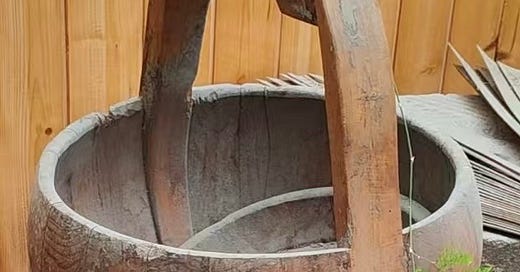MuShangYouShui, Jing, JunZiYiLaoMinQuanXiang
木上有水,井,君子以勞民勸相
There is water on the wood, this is a natural image of well. Learning from this, the refined person encourages people to work hard and persuades them to help one another.
Again, the first four Chinese words of the Jing ䷯, Hexagram DaXiang sentence describes the symbolic image of the hexagram, which we have seen is the typical pattern of the DaXiang. The first character, Mu 木 , means wood, and it represents the bottom trigram Xun 巽 ☴. The second character Shang 上 , means above, over, on, or on top and it describes the position of an object or situation. You 有 means exist, have/has, or there be. Shui 水 means water, and represents the top trigram, Kan 坎 ☵, of the hexagram. Put together, the natural image of the Jing hexagram is water over the wood. The fifth word, Jing 井 means well, neat, orderly, or hometown. This is the name of the hexagram ䷯.
You might be wondering why the image of water on top of wood symbolizes the Jing/Well hexagram. At first, I also had hard time understanding the connection between this image and the hexagram, until it suddenly clicked with my childhood memories of fetching water from our well.



